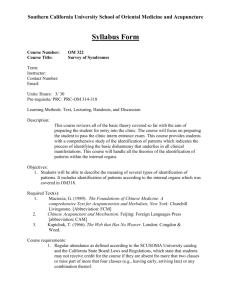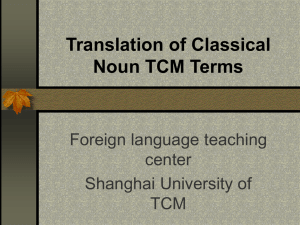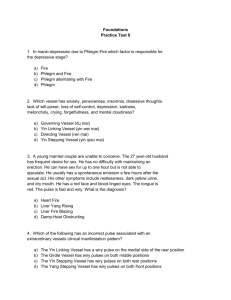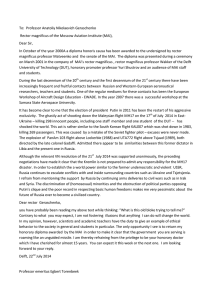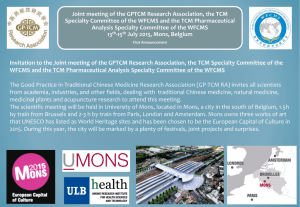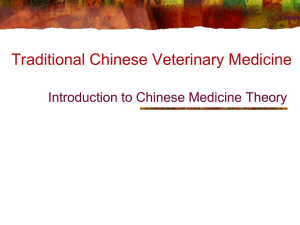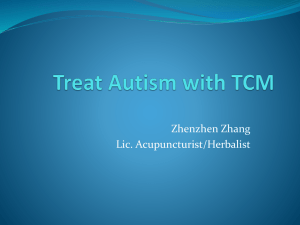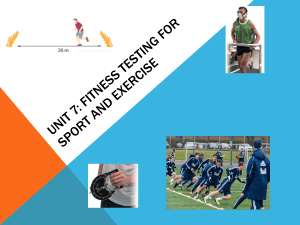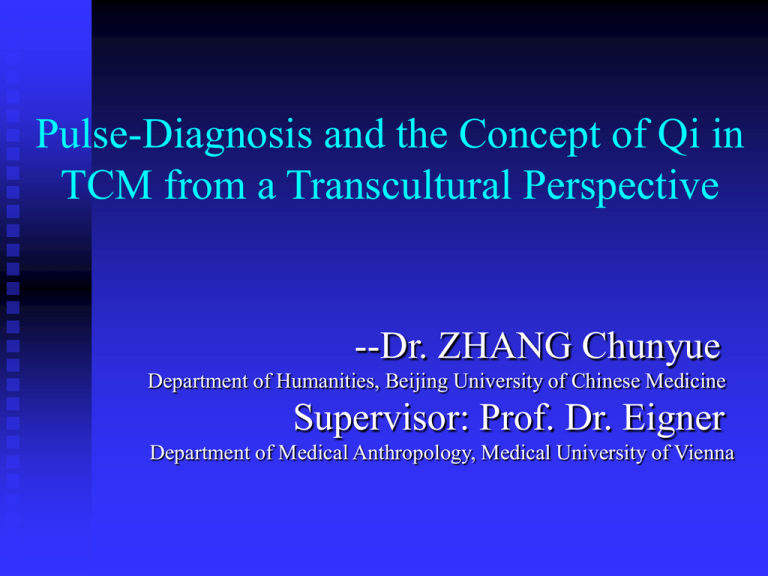
Pulse-Diagnosis and the Concept of Qi in
TCM from a Transcultural Perspective
--Dr. ZHANG Chunyue
Department of Humanities, Beijing University of Chinese Medicine
Supervisor: Prof. Dr. Eigner
Department of Medical Anthropology, Medical University of Vienna
Contents:
1. Pulse manifestations
2. Qi exercises
3. Brief introduction of TCM (Traditional Chinese
Medicine)
1.Pulse Manifestation
• (1)location and method
• (2) feeling practice
• (3) brief introduction
• (4) Practice in patients
• (5) Case examples
(1) Location and method
• Location: cun, guan, chi
The guan (Second) position is found
opposite the styloid process of the radius,
the cun is between the guan and the wrist,
and the chi is at a point equal the distance
between guan and cun.
• Methods:
Method:
• The different points of the pulse felt on the
wrist represent the functions of different
organs.
TCM
Names
Left hand
cun
position
Heart
meridian
Right hand Lung
meridian
guan
position
Liver
meridian
Stomach
and spleen
M.
chi
position
Kidney
(yin) M.
Vital gate
(kidney
yang) M.
The pulse is differentiated in
depth, speed, strength, shape and rhythm.
A normal pulse is smooth, even and forceful
with the frequency of four beats per breath
(approximate 60/min).
A pulse may vary due to age, sex, and body
constitution, emotional state and climatic
changes.
(2) Feeling practice
• The first step:
depth, speed,
• The second step:
strength, and rhythm
• The third step:
shape
• The 4th step
find the healthy pulse
• The 5th step
abnormal pulses
(3)Introduction of abnormal pulses
• Floating (fu mai): Pulse responds to finger on light pressure but
becomes weak on heavy pressure
Exterior syndrome
• Deep (chen mai): Not clear with light pressing; clear with heavy
pressing
Interior syndrome
• Slow (chi mai) Rate: is less than 4 beats per breath (less than
60/min)
Cold syndrome
• Rapid (shu mai)Rate: is more than 5 beats per breath (more than
90/min)
Heat syndrome
• Deficiency (xu mai): Lack of force, empty and vacuous with
pressure
Deficiency in qi (vital energy) and blood
• Excess (shi mai): Forceful with touching and pressing
Excess syndrome, heat syndrome
• Rolling (hua mai):Smooth and flowing like pearls rolling on
a dish.
Phlegm and fluid detention, excess heat and food retention.
But it is also usual in healthy people with ample qi (vital energy)
and blood, and in pregnant women.
• Hesitant (se mai) Rough and uneven, opposite to rolling pulse.
Stagnation of qi (vital energy) or blood, impairment of
essence, and deficiency of blood.
• Thready (xi mai) Feels like a fine thread but is very distinct
and clear.
Deficiency due to overstrain and stress or deficiency of qi
(vital energy) and blood.
• Surging (hong mai) Feels broad, large and forceful like
powerful waves that ebb and flow.
Excessive heat
• Taut (xuan mai): Feels taut, straight and long,
like the string of a violin
Disorders of the liver and gall-bladder, painful
syndromes, and phlegm and static fluid detention.
• Tense (jin mai): Feels tight and forceful like a
stretched rope.
Syndromes of cold, pain and retention of
food.
• Knotted (jie mai):Slow and gradual with
irregular or missed beats.
Serious conditions with impairment of qi
(vital energy) and blood and declining yang-qi.
Practice or examples
Introduction
Four diagnostic methods in TCM
• Inspection
• Auscultation and olfaction
• Inquiry
• Pulse-taking and palpation
Introduction of details of inquiry
十问歌
• 一问寒热二问汗, 三问头身四问便
• 五问饮食六胸腹,七聋八渴具当辨.
• 九问旧病十问因,再兼服药参机变.
• 妇女犹需问经期,天花麻疹全占验.
Qigong Exersice
• Daoism exercise
Taiji Quan
• Sunshi Taiji
(5-10min)
3. Brief introduction of TCM
(Traditional Chinese Medicine)
• (1) Background generating TCM theories
• (2) Characteristics of TCM theories
• (2) Basic terms
Background generating TCM theories
• 1. Zhouyi (Chou yi; Chou I; I)
• 2. Huang and Lao Philosophy
•
Daoism
• 3. Agriculture society
•
nature,
•
climate,
•
geography
Characteristics of TCM theories
• repeatability
• Reasoning from factual knowledge or evidence
• It is not a symbolic math, while there is math logic in it.
Natural sciences inquiry into the nature of things based on
logical reasoning rather than empirical methods.
TCM, character math,
Logical deduction by reasoning comes to the third step.
Introduction of TCM Terms
• 1. qi
one
• 2. yin and yang
two
•
qi and xue (the blood)
• 3. five elements
three
•
metal (jin), earth (tu), fire (huo-kidney yang)
•
fire (huo-heart qi), wood (mu), water (shuikidney yin)
•
shown in the pulse manifestation
• 4. pathogenic factors:
• Wind, fire, summer-heat, dampness, dry, cold
• 5. Eight principles in Diagnoses
(pathogenesis)
• (1) yin and yang
• (2) the interior and exterior
• (3) cold and heat
• (4) excess and deficiency
• 6. Five zang and six fu
• Five zang: xin, gan, pi, fei, shen.
• heart, liver, spleen, lung, kidney: the related
structure and function of the five organs and
brain, pancreas, gall bladder,
Huangdi Neijing
Huangdi’s Classic on Medicine
• 从阴阳则生,逆之则死;
从之则治,逆之则乱。
反顺为逆,是谓内格。
是故圣人不治已病治未病,不治已乱治
未乱,此之谓也。
夫病已成而后药之,乱已成而后治之,
譬犹渴而穿井斗而铸锥,不亦晚乎!
• Following the principle of yinyang ensures life, while breaking them
may lead to death; conforming to the principles of yinyang guarantees
health, while violating them may result in disease.
• The movement from conformity to violation is known as interior
rejection.
• Therefore, wise doctors give prevention the priority over treatment,
and pay less attention to the treatment of disease but more to the
prevention of disease.
• This is the reason.
• Applying medicine only when disease has emerged, and resorting to
treatment when disorder has appeared, are just like drilling a well
when one feels thirsty, and manufacturing weapons when war has
already broken out. It is certainly too late!
• //
• Man will survive when following the law of yin and yang, and dies
when acts against it.
• If the yang energy fails to enter into the body and yin energy can not
come out from the body, the favorable condition of health will turn to
the adversity, the contradiction between exterior and interior will cause
the disease of mutual excluding of yin and yang.
《灵枢 经脉》:
• 肺手太阴之脉:起于中焦,下络大肠,
还循胃口,上膈属肺。从肺系,横出腋
下,下循臑内,行少阴、心主之前,下
肘中,循臂内上骨下廉,入寸口,上鱼,
循鱼际,出大指端。
其支者:从腕后,直出次指内廉,出其
端。
Lingshu · Meridians
•
•
•
Lung Meridian of Hand Taiyin
The Lung Meridian of the Hand Taiyin originates from the Zong Jiao
(stomach), and descends to connect with the large intestines. It then turns back
and goes along the upper orifice of the stomach, passing through the
diaphragm and enters the lung (the pertaining organ) and exits transversely
from the arm pit. It then descends along the anterior-medial side of the upper
arm, going in front of the Hand Jueyin, and reaches the elbow. It then goes
downward along the radial side on the medial aspect of the forearm and enters
the cunkou (anterior margin of the styloid process at the wrist) where the radial
artery at the wrist palpates. It then passes through the major thenar eminence
and goes along its radial border and goes out to end at the medial side of the
tip of the thumb.
A branch of this meridian splits from the styloid process of the wrist
(Lieque point, LU7), and runs to the radial side of the tip of the index finger,
where it connects to the Large Intestine Meridian of the HanD Yangming.
quotation
Bibliography

